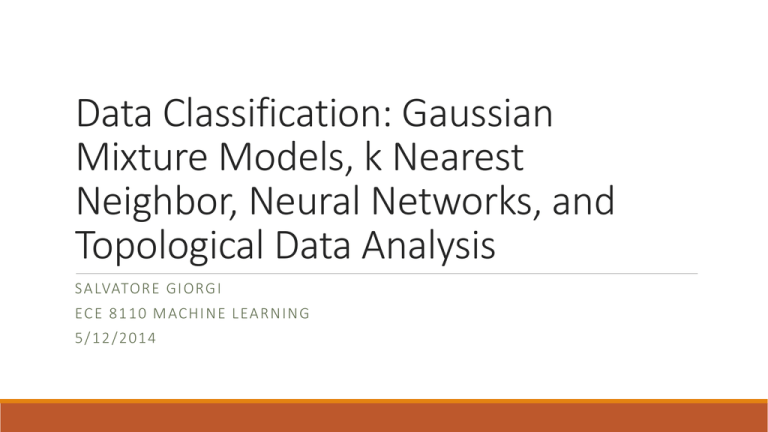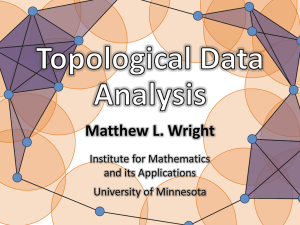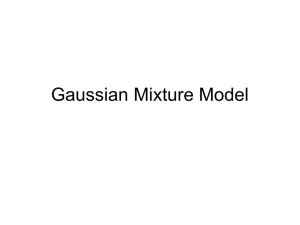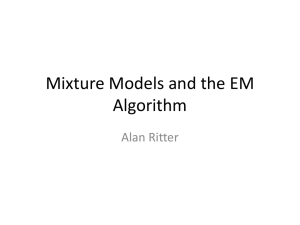Gaussian Mixture Models, k Nearest Neighbor, Neural Networks
advertisement

Data Classification: Gaussian Mixture Models, k Nearest Neighbor, Neural Networks, and Topological Data Analysis SA LVATORE G I ORG I ECE 8 1 1 0 MACHI N E L EA R NI NG 5 / 1 2/2014 Gaussian Mixture Models •An iterative clustering method •Formed by combining multivariable Normal density components •The Matlab function we use fits data using an Expectation Maximization (EM) algorithm Figures taken from Duda and Hart Gaussian Mixture Models: Algorithm •First, we compute the sample means of each class in the training data •Use fitgmdist function for total training data with regularization parameter and a number of mixtures •Number of mixtures is always a multiple of 11 or 5, the number of classes corresponding to data set 1 and 2, respectively •The regularization parameter ensures estimated covariance matrices are positive definite •We then find the smallest distance between each class sample mean and each mixture •Assign to each mixture the class associated with this minimum distance •Use the cluster function to cluster our test data •Count number of incorrect classifications •Probability of Error = number of incorrect class assignments / number of test vectors Gaussian Mixture Models: Results Data 1 •Minimum Error = 54.4% •Number of Mixtures per Class = 21 •Regularization Variable = 0.001 Gaussian Mixture Models: Results Data 2 •Minimum Error = 27.1% •Number of Mixtures per Class = 11 •Regularization Variable = 1 K Nearest Neighbor •A non-parametric classification method •Object is classified by majority vote of the class assignments of the k closest elements •We use a Euclidean distance metric Figures taken from Wikipedia K Nearest Neighbor: Algorithm •Use knnsearch function with training data, test data, and k •Returns a vector where each row contains index of the k nearest neighbors in training set for the corresponding row in Y •Since we know the classes of each test vector, we can assign classes to the above output based on the index •We then take a majority vote of the classes from each of the k neighbors •This majority vote is then compared to the actual class •Probability of Error = number of incorrect class assignments / number of test vectors K Nearest Neighbor: Results Data Set 1 •Minimum Error = 39.3% •K = 6 K Nearest Neighbor: Results Data Set 2 •Minimum Error = 24.9% •K = 45, 47, and 48 Neural Networks •A computational model inspired by Neuroscience •A large number of simple computational devices are interconnected •Proven that a neural network with an arbitrary number of hidden layers, each containing a sigmoidal neural function, can approximate any Ndimensional continuous function Figures taken from Duda and Hart Neural Networks: Algorithm •Architeture and Neural Functions kept constant •Single hidden layer with Tansig neural function / Single output layer with Softmax neural function •Vary number of neurons in hidden layer: [1, 5, 10, 100, 1000, 10000] •Training data is split into three sets: training set, validation set, and test set •Vary percentage of training set: [60, 70, 80, 90, 95] •Remaining data split 50/50 between validation and test set •Vary training function: [trainlm, trainbr, trainscg, trainrp] Neural Networks: Results Data Set 1 Percentage of Data Used for Training Number of Neurons in Hidden Layer 60 70 80 90 95 1 71.0 72.3 71.2 72.6 70.7 5 56.5 58.8 56.5 50.9 56.2 10 48.6 54.9 55.4 43.8 50.4 100 40.4 44.1 42.5 43.0 42.0 1000 48.8 45.9 45.1 44.6 46.4 10000 71.2 69.1 77.0 68.3 87.9 These results are for the Scaled Conjugate Gradient Back Propagation (trainscg) training method, which is the default setting. Neural Networks: Results Data Set 2 Percentage of Data Used for Training Number of Neurons in Hidden Layer 60 70 80 90 95 1 58.0 57.7 56.3 56.6 56.6 5 24.3 25.1 25.7 32.6 26.0 10 21.7 22.3 22.6 24.0 31.4 100 24.0 24.6 24.9 23.4 25.4 1000 28.0 30.0 25.7 28.3 28.0 10000 31.4 30.3 28.3 26.0 28.3 These results are for the Scaled Conjugate Gradient Back Propagation (trainscg) training method, which is the default setting. Comparison of GMM, kNN, and NN DATA SET 1 DATA SET 2 •GMM: 54.4% •GMM: 27.1% •kNN: 39.3% •kNN: 24.9% •NN: 40.4% •NN: 21.7% Topological Data Analysis •How does one visualize high dimensional data? •Can one infer high dimensional structure from low dimensional representations? •How can one infer global (possibly continuous) structure from local discrete points? •Tools from Algebraic Topology can attempt to answer these questions, using the JavaPlex software within Matlab Image taken from Robert Ghrist ‘Barcodes: The Persistent Topology of Data’ Topological Data Analysis: Preliminaries Simplicial Complex A space formed by gluing together points, lines, and faces. Homology Group For a space X and integer k we assign a vector space Hk(X). For a continuous function on spaces f: X →Y, we get a map on homology groups Hk(f): Hk(X) → Hk(Y) Betti Number Rank of the Homology Group. Informally, the kth Betti Number refers to the number of k dimensional holes in a space. Image taken from Robert Ghrist ‘Barcodes: The Persistent Topology of Data’ Topological Data Analysis: Preliminaries Filtered Complex A collection of ordered complexes, which is ordered by containment. Persistent Homology Computation of topological features of a space at different spatial resolutions. Barcodes Way of viewing the persistence as the spatial resolution increases. Image taken from Robert Ghrist ‘Barcodes: The Persistent Topology of Data’ Topological Data Analysis: Results Fig: Total Training Set Fig: Class 1 in Training Set Fig: Class 7 in Training Set Class Total 1 2 3 4 5 6 7 8 9 10 11 0-Betti Number 1 4 3 2 3 1 1 1 2 3 3 3 Thank you. Questions?











